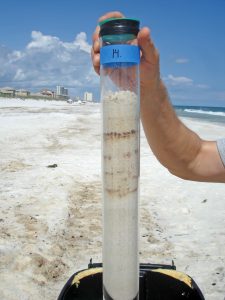Study: Dispersants Can Move Hydrocarbons Faster and Deeper into Gulf Sand
– May 10, 2013
Scientists studying the fate of oil from the Deepwater Horizon incident published their findings in the November 2012 edition of Public Library of Science (PLoS ONE): Dispersants as used in response to the MC252-spill lead to higher mobility of polycyclic aromatic hydrocarbons in oil-contaminated Gulf of Mexico sand.
Researchers concluded that the addition of dispersants can increase the movement of polycyclic aromatic hydrocarbons (PAHs) in saturated (wet) permeable sediments of up to two orders of magnitude.
Researchers collected samples of water, sediment, and sand from Santa Rosa Island, Florida. They conducted laboratory experiments using sand-filled columns of various lengths ranging from 10 to 50 cm, and they conducted in-situ chamber experiments in the Gulf to link laboratory results to the natural environment. The column experiments showed that PAHs can move from the water column into sands, and that the addition of dispersants to the water percolating the sand determines the penetration depth of the PAHs. The in-situ chamber tests confirmed laboratory findings for natural settings. From the results of these two experiments, researchers concluded that the presence of dispersants allow oil components to permeate faster and deeper into sands.
In their discussion, the authors suggest two possible impacts on oil degradation as a result of PAHs moving deeper and faster into sands: (1) the deeper penetration of hydrocarbons may slow their degradation due to the decreased concentration of oxygen in deeper sediment layers and thus extend the time these hydrocarbons stay in the environment; and (2) in fully oxygenated sands, a deeper penetration may increase the number of microbes involved in the hydrocarbon biodegradation and thus accelerate the decomposition. Deeper penetration of hydrocarbons into permeable coastal sediment facilitated by dispersants could have potential impacts to groundwater.
The study authors are Alissa Zuijdgeest and Markus Huettel (PLoS ONE 7(11): e50549).
- Markus Huettel
- Alissa Zuijdgeest
########
This research was made possible in part by a Grant from BP/The Gulf of Mexico Research Initiative (GoMRI) through the Florida Institute of Oceanography and the Deepsea to Coast Connectivity in the Eastern Gulf of Mexico (DEEP-C) Consortium. Other funding sources included the National Science Foundation OCE-1044939 and OCE-1057417.
The GoMRI is a 10-year independent research program established to study the effect, and the potential associated impact, of hydrocarbon releases on the environment and public health, as well as to develop improved spill mitigation, oil detection, characterization and remediation technologies. An independent and academic 20-member Research Board makes the funding and research direction decisions to ensure the intellectual quality, effectiveness and academic independence of the GoMRI research. All research data, findings and publications will be made publicly available. The program was established through a $500 million financial commitment from BP. For more information, visit https://gulfresearchinitiative.org/.
© Copyright 2010- 2017 Gulf of Mexico Research Initiative (GoMRI) – All Rights Reserved. Redistribution is encouraged with acknowledgement to the Gulf of Mexico Research Initiative (GoMRI). Please credit images and/or videos as done in each article. Questions? Contact web-content editor Nilde “Maggie” Dannreuther, Northern Gulf Institute, Mississippi State University (maggied@ngi.msstate.edu).








